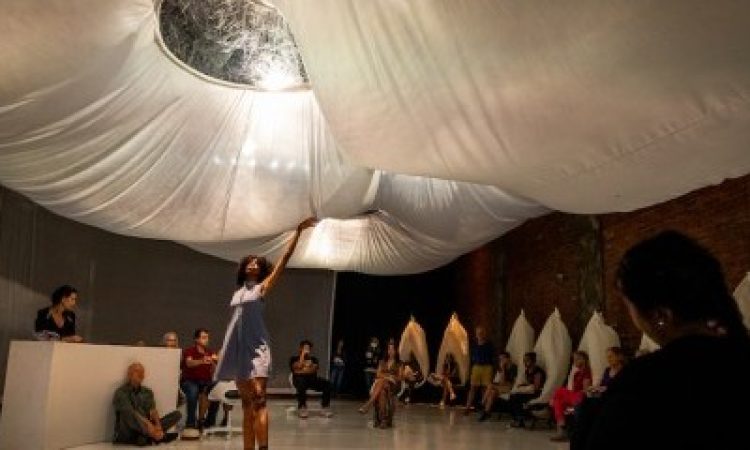Writing about the highly ambitious and serenely transporting Rhythm Bath, the immersive performance installation of choreographer Susan Marshall and set designer Mimi Lien, makes me aware that one dance writer who is not disabled cannot know the responses of audience members with disabilities. Designed in collaboration with neurodivergent advisors it seeks to invite both neurodivergent and neurotypical audiences, as well as audience members with various physical and invisible disabilities. Their responses may require another forum for expression to realize the full potential of audience “accessibility.”
All the esthetic elements of Rhythm Bath – dance, sound, costumes, lighting and installation environment – are deftly aligned here to create an air of a gentle, welcoming embrace. It extends to all of us whether we choose to be on rolling, set, or motorized chairs, cocoon-like seats, or standing or lying down. It’s a warm, come-as-you-are vision. Marshall’s pared down movement ranges from cool, undulating walks in place to highly playful, accelerating jumps and skips with percussive stepping marking the beat. A woman in the audience with Down Syndrome joyfully mirrors the circling arm gestures and rhythmic beats. Some of the most impactful moments come when the tempo slows. Dancers’ torsos sway or come to a complete rest, often in mutual embrace, sometimes to silences of the ambient and tonal sound score, sometimes to what sounds like light rain falling.
The Lien installation provides a celestial embrace to the grounded embrace of the dancers. A large parachute-like white fabric extends and lowers just about five feet above our heads, spanning the length of the Christ Church Neighborhood House loft space. Astonishingly, it pulses, seemingly inhaling and exhaling, embodying a breath from the heavens. Four round apertures in the fabric reveal fiber optic lights and what look to me like crystalline galaxies in the distance. Toward the work’s conclusion, the billowing breath of the white fabric increases in intensity as the rain sounds grow, and I feel a cooling breeze. My body releases in response. Lien’s organic white clouds were the highpoint for an audience member in a wheelchair I spoke to afterwards. She described how she viewed the dancers’ movement changing in response or relation to the pulsating fabric.
In an interview with Lisa Sonneborn of the co-producing Temple University Institute on Disabilities, she explained the effort to “embed accommodations into all performances.” Among a multiplicity of accommodations were a “Quiet Lounge” for those needing a sensory break and even a “sensory timeline” demarking in advance the dancing speed and sound volume and their intensities for each of the dance’s nine sections.
For me, one of the most striking examples of this deep dive into accommodations was a deaf and blind audience member first aided by an audio interpreter. In turn, they communicated with a tactile ASL interpreter communicating using their hands and touch. This became its own lively, gestural dance-within-the-dance.
It is the very high aspiration of Rhythm Bath that invites the question: Why not complete the circle of full access by including dancers with disabilities into the piece? In this way performer norms of non-diversity can be unshackled, and audience members with disabilities can see themselves in the performance. No dancers in their bios self-identify as disabled and the call for dancers did not expressly seek them out. Other companies employing dancers with disabilities like, Kinetic Light, Axis Dance Company and Candoco Dance Company, have demonstrated that high performance standards are amply present among differently abled dancers. The concept of a universal access for performance was recently articulated by Alice Sheppard, founder and artistic director of Kinetic Light: “We’re thinking about access as an ethic, as an aesthetic, as a practice, as a promise, as a relationship to the audience.”
Rhythm Bath’s very success in achieving a collective experience of meditation and joy for a diverse audience holds a promise of a greater inclusiveness to come.
Rhythm Bath, dance installation by Susan Marshall and Mimi Lien, co-produced by Temple University Institute on Disabilities and Studio Susan Marshall, Philly Fringe Festival, Sept. 17-24.
(Dancers are Rohan Bhargava, Ching-I Chang, Sydney Donovan, Nico Gonzales, Courtney Henry, Shayla-Vie Jenkins, Vanessa Knouse, Albert Quesada, Gabrielle Revlock, Darrin Michael Wright; lighting by Jeanete Yew and Vittoria Orlando; music/sound by Dan Trueman and Jason Treuting; costumes by Oana Botez; assistant set designer, Tatiana Kahvegian.






